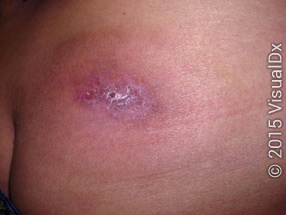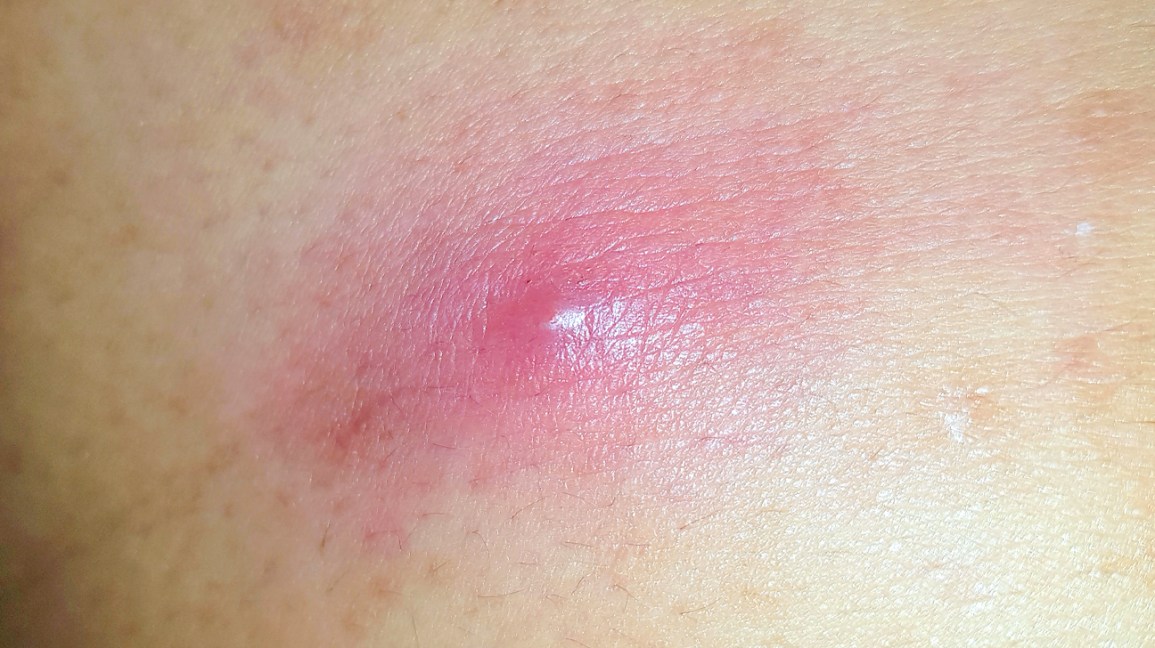
An abscess caused by a bacterial infection is a walled off collection of pus. They most commonly develop on the back, buttocks, and certain areas of the face. Skin abscesses can also develop on the armpit, pubic area, or in a hair follicle. A bacterial infection causes the pus to drain from the follicle into the skin.
The body responds to this invasion by creating an inflammatory response by trapping the infected object within a capsule or cavity. The immune system then forms a lining that prevents the infection from spreading. This lining liquefies the inside of the abscess and creates a pus-filled space. The pus is made up of bacteria, dead cells, proteins, and debris. As it rises, it can cause inflammation of the overlying skin.
An abscess caused by a bacterial infection is usually small and can be treated at home with a warm compress. Larger abscesses may need draining at a medical facility. The doctor will then determine if you need antibiotic treatment. Typically, antibiotics are prescribed for people with a weakened immune system or whole body symptoms, such as fever. The doctor may also take a sample of the abscess’ pus to test for antibiotic resistance.
Abscesses caused by a bacterial infection can be painful and require medical attention. If left untreated, the abscess will grow and spread to deeper tissues and the bloodstream. If an abscess has a deep location, it can cause a fever and feel ill. Abscesses caused by a bacterium can cause the patient to have a fever and experience chills. Fortunately, small skin abscesses usually drain on their own without any treatment.
Although it may initially seem like a harmless skin infection, an abscess caused by a bacterial infection can be very painful. In addition to the pain, an abscess can also be red or swollen and hot to the touch. A physician will assess the symptoms and prescribe the right treatment. The doctor may take a sample of the pus for culture testing or other tests to confirm the cause of the infection.
An abscess caused by bacterial infection is often difficult to treat. However, if it has spread to other parts of the body, it may lead to a bacterial infection. In some cases, the bacterium can cause an abscess due to a bacteria that has entered the body through an open wound. When the abscess is too large, it may have to be drained surgically. If a bacterium has infected the surrounding tissue, a surgical procedure is needed to remove the foreign body and drain the pus.

An acute infection can also cause a brain abscess. The doctor may treat the abscess by administering antibiotics. The doctor will also recommend a warm compress on the affected area. If the abscess is large, the doctor drains the pus and examines the area. The patient will be given antibiotics for a short time after infection. Site https://handaldok.com/
may recommend a course of therapy depending on the severity of the condition and underlying causes.
An abscess is a type of infection that is characterized by inflammation of the surrounding tissues and bacteria causing the infection. It is best to seek immediate medical attention if an abscess occurs in a sensitive area, such as the skin. A puncture wound is often a source of infection. It should be treated as soon as possible to avoid further complications. A patient suffering from an abscess may experience pain, swelling, or fever.
An abscess can be painful and may be a symptom of an underlying disease. It can happen on the skin or inside the body. If it doesn’t go away, it’s best to see a doctor. The abscess may also spread to deeper body tissues and into the bloodstream. If it enters the bloodstream, it can lead to a fever or rash.
An abscess can occur in any part of the body. This is a painful infection that can affect underlying tissues. An abscess on the skin can cause pain and fever. In severe cases, an abscess can become infected with a bacterium and affect the organ. A skin abscess can be very small and should be examined by a doctor immediately.

Leave a Reply